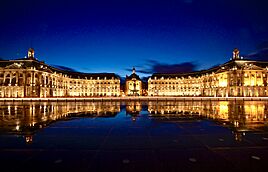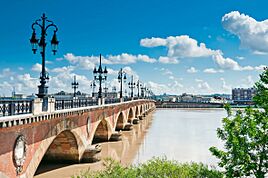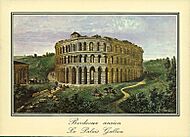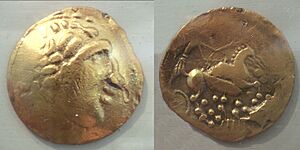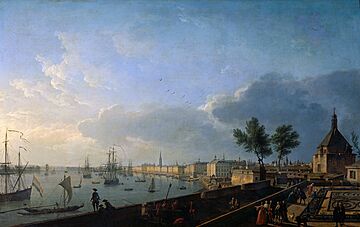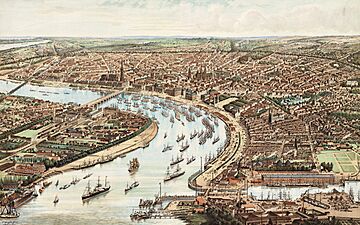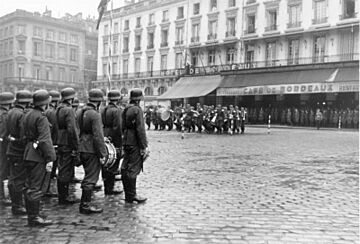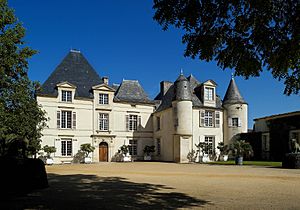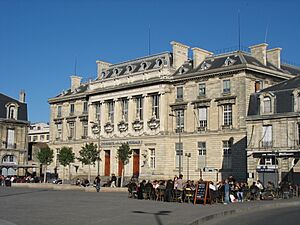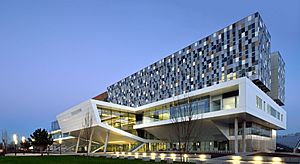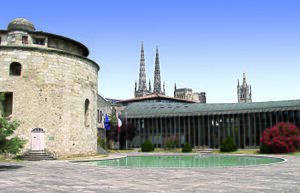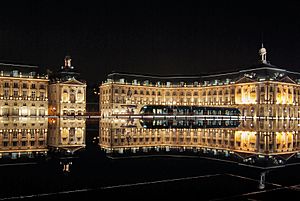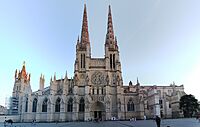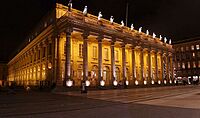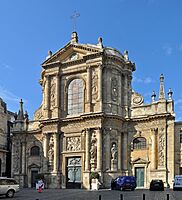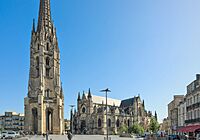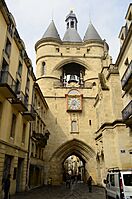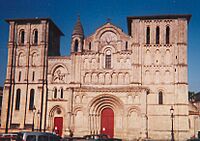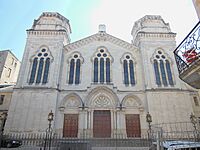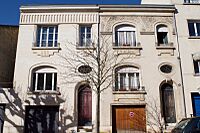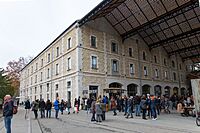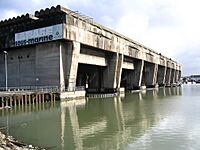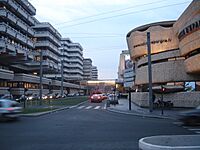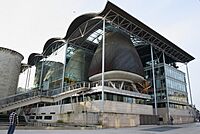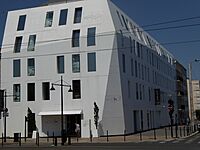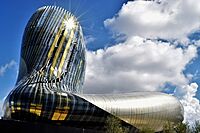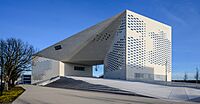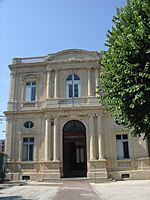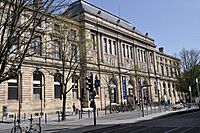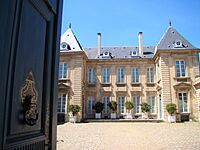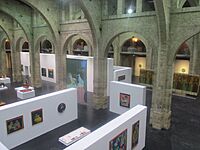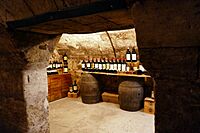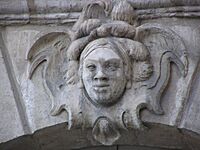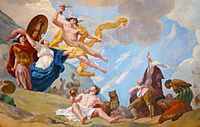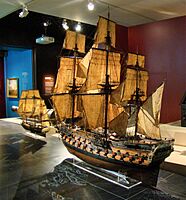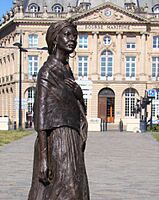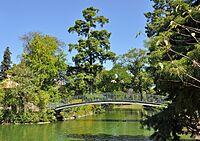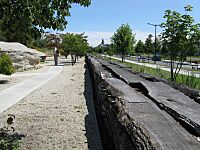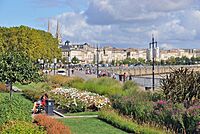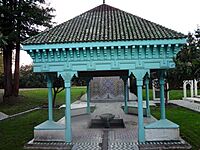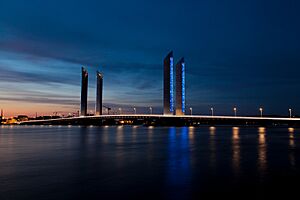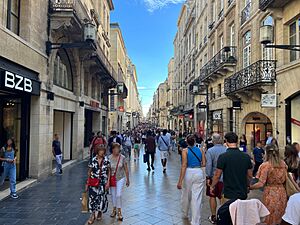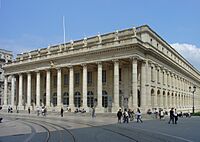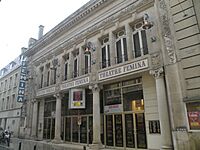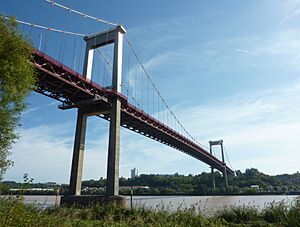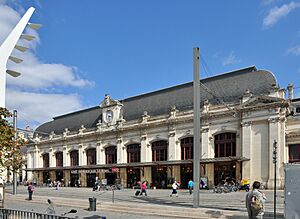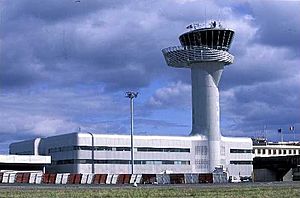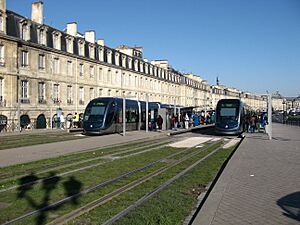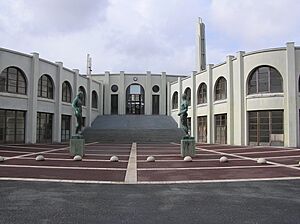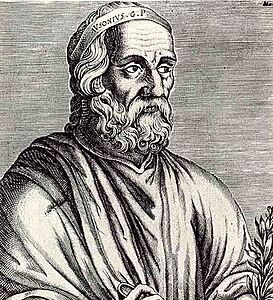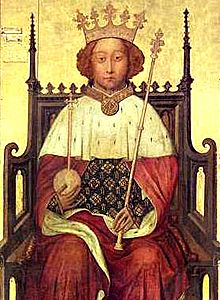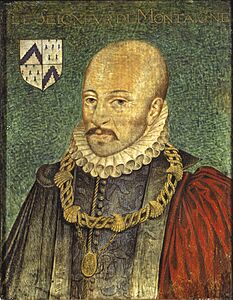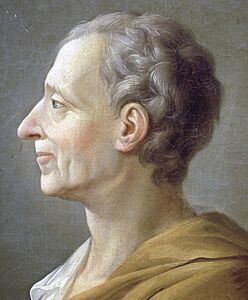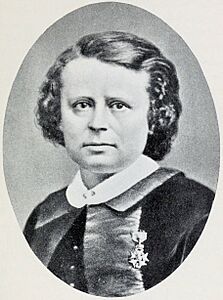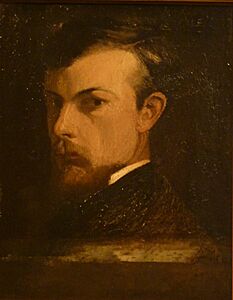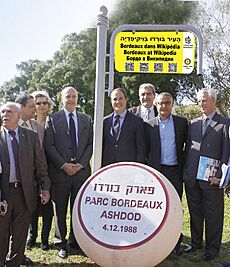Bordeaux facts for kids
Quick facts for kids
Bordeaux
Bordèu (Occitan)
|
|||
|---|---|---|---|
|
Prefecture and commune
|
|||
|
From top to bottom, left to right: Place de la Bourse, Cité du Vin, Monument aux Girondins, Tour Pey-Berland, Grosse Cloche, Grand Théâtre de Bordeaux, Saint-André Cathedral and Pont de pierre on the Garonne
|
|||
|
|||
| Motto(s):
Lilia sola regunt lunam undas castra leonem.
"The fleur-de-lis alone rules over the moon, the waves, the castle, and the lion" (in French: "Les lys règnent seuls sur la lune, les ondes, la forteresse et le lion.") |
|||
| Country | France | ||
| Region | Nouvelle-Aquitaine | ||
| Department | Gironde | ||
| Arrondissement | Bordeaux | ||
| Canton | 5 cantons | ||
| Intercommunality | Bordeaux Métropole | ||
| Area
1
|
49.36 km2 (19.06 sq mi) | ||
| • Urban
(2020)
|
1,287.3 km2 (497.0 sq mi) | ||
| • Metro
(2020)
|
6,315.6 km2 (2,438.5 sq mi) | ||
| Population
(2021)
|
261,804 | ||
| • Rank | 9th in France | ||
| • Density | 5,304.0/km2 (13,737.2/sq mi) | ||
| • Urban
(Jan. 2020)
|
994,920 | ||
| • Urban density | 772.87/km2 (2,001.73/sq mi) | ||
| • Metro
(Jan. 2020)
|
1,376,375 | ||
| • Metro density | 217.9326/km2 (564.443/sq mi) | ||
| Demonym(s) | Bordelais | ||
| Time zone | UTC+01:00 (CET) | ||
| • Summer (DST) | UTC+02:00 (CEST) | ||
| INSEE/Postal code |
33063 /
|
||
| Website | |||
| UNESCO World Heritage Site | |||
| Official name | Bordeaux, Port of the Moon | ||
| Criteria | Cultural: ii, iv | ||
| Inscription | 2007 (31st Session) | ||
| Area | 1,731 ha | ||
| Buffer zone | 11,974 ha | ||
| 1 French Land Register data, which excludes lakes, ponds, glaciers > 1 km2 (0.386 sq mi or 247 acres) and river estuaries. | |||
Bordeaux is a famous city in southwestern France. It sits on the Garonne river. It is the capital of the Nouvelle-Aquitaine region. People from Bordeaux are called "Bordelais" (for boys and men) or "Bordelaises" (for girls and women).
In 2020, about 259,809 people lived in Bordeaux itself. But if you include its nearby towns, the greater Bordeaux area had 1,376,375 people. This makes it the sixth largest city area in France.
Bordeaux is known as a world capital for wine. Many vineyards are found on the hills around the city. It also hosts Vinexpo, a major wine fair. Bordeaux is a hub for food and business tourism. It is also important for the aerospace and defense industries. Companies like Dassault Aviation and Thales Group are located here. The city has a megajoule laser, one of only two in the world. It also has over 130,000 students.
Bordeaux is a popular place for tourists. It has over 362 historic buildings, more than any French city except Paris. In 2015, it was voted European Destination of the year. In 2007, the historic "Port of the Moon" area was added to the UNESCO World Heritage List. This was because of its amazing architecture and its importance over 2000 years.
Contents
History of Bordeaux
Early History: From Celts to Romans
Around 300 BC, a Celtic tribe called the Bituriges Vivisci lived here. They named the town Burdigala. The name likely came from the Aquitanian language.
In 107 BC, the Romans fought a battle here. They were defeated by the Tigurini tribe. The city came under Roman rule around 60 BC. It became an important trading center for tin and lead. During this time, the Roman amphitheater and the Les Piliers de Tutelle monument were built.
The city was attacked by different groups in the 3rd and 5th centuries. These included the Vandals, Visigoths, and Franks. After these attacks, Bordeaux became less important for a while.

In the late 500s, Bordeaux became important again. It was the seat of a county and an archdiocese. In 732, the city was attacked by troops led by Abd er Rahman. Later, in 737, the Frankish leader Charles Martel captured Bordeaux.
The city faced attacks from Vikings and Normans around 844. Despite this, the port of Bordeaux was a busy trade center. The return of the Dukes of Aquitaine helped bring stability.
English Rule and Growth (12th to 15th Century)
Bordeaux thrived from the 12th to the 15th century. This happened after Eleanor of Aquitaine married Henry II of England. Henry became King of England, creating a large empire.
He gave Bordeaux special tax-free trade status with England. This helped the city's wine trade, which was its main income. Bordeaux also benefited from importing cloth and wheat. During this time, the Grosse Cloche belfry and Saint-André Cathedral were built. In 1453, after the Battle of Castillon, Bordeaux became part of France.
From the 15th to 17th Century
In 1462, Bordeaux created its own local parliament. The city was finally fully joined with the Kingdom of France in 1653. This happened when the army of Louis XIV of France entered the city.
The Golden Age of the 18th Century
The 18th century was a golden age for Bordeaux. The Port of the Moon became France's busiest port. It was the second busiest in the world after London. It supplied Europe with goods like coffee, cocoa, sugar, and cotton. Many buildings in the city center, including those along the quays, were built during this time.
Bordeaux was also involved in the slave trade. Shipowners from Bordeaux carried about 150,000 Africans on around 500 voyages.
French Revolution and Economic Changes
At the start of the French Revolution in 1789, many local revolutionaries were called Girondists. This group wanted to end the special rights of the rich. But they were against the revolution's social changes.
In 1793, the Montagnards took power. They executed many Girondists. During this time, Bordeaux was briefly renamed "Commune-Franklin."
In 1791, a slave revolt began in Saint-Domingue (now Haiti). This was France's most profitable colony. Bordeaux's economy relied heavily on trade with this colony. In 1794, slavery was abolished. Napoleon later brought it back, but France lost the war against the former slaves. Haiti became independent in 1804. This loss greatly hurt Bordeaux's port economy.
Towards the end of the Peninsular War in 1814, British troops took Bordeaux. The city was largely against Napoleon and supported the Bourbons. The British were seen as liberators.
Rebirth in the 19th Century
After the Bourbon Restoration, Bordeaux's economy grew again. Traders and shipowners built the first bridge in Bordeaux. They also built customs warehouses. Shipping traffic increased with new African colonies.
Georges-Eugène Haussmann, a former leader of Bordeaux, used the city's 18th-century rebuilding as a model for Paris. He helped transform Paris into a modern capital. The writer Victor Hugo said Bordeaux was so beautiful it was like "Versailles, plus Antwerp."
The French government moved to Bordeaux temporarily during the Franco-Prussian war in 1870. This also happened during World War I and briefly in World War II.
Bordeaux in the 20th Century
During World War II, Bordeaux was under German occupation.
In 1940, the Portuguese consul-general, Aristides de Sousa Mendes, saved thousands of refugees. He illegally gave them Portuguese visas to escape the Germans.
From 1941 to 1943, the Italian Royal Navy built a submarine base in Bordeaux called BETASOM. This base was also used by German U-boats. The large concrete U-boat pens are still there today. They are now partly used as a cultural center.
Bordeaux in the 21st Century
In 2007, 40% of Bordeaux's city area was listed as a World Heritage Site. This area is around the Port of the Moon. UNESCO called it "an outstanding urban and architectural ensemble." It was built during the Age of Enlightenment.
Geography and Climate
City Location and Layout
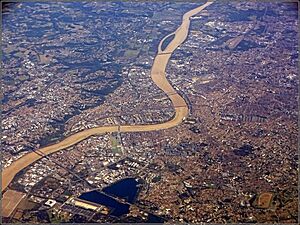
Bordeaux is located in southwestern France. It is near the European Atlantic coast. The city is about 500 km (310 mi) southwest of Paris. Bordeaux is built on a bend of the Garonne river. It has two parts: the right bank to the east and the left bank to the west.
Historically, the left bank was more developed. This was because the river was deeper there, allowing merchant ships to dock easily. Today, the right bank is also growing with new city projects. The Garonne River in Bordeaux is deep enough for large ocean liners to reach the city through the Gironde estuary.
Bordeaux's Climate
Bordeaux has an oceanic climate. This means it has cool to mild, wet winters. This is due to its location and mild winds from the Atlantic. Summers are warm and a bit drier.
Frosts happen every year, but it rarely snows. Snowfall occurs only about 3–4 days a year. The summer of 2003 was very hot, with an average temperature of 23.3 °C (73.9 °F). February 1956 was the coldest month on record, with an average temperature of −2.00 °C (28.40 °F).
| Climate data for Bordeaux (BOD), elevation: 47 m (154 ft), 1991–2020 normals, extremes 1920–present | |||||||||||||
|---|---|---|---|---|---|---|---|---|---|---|---|---|---|
| Month | Jan | Feb | Mar | Apr | May | Jun | Jul | Aug | Sep | Oct | Nov | Dec | Year |
| Record high °C (°F) | 20.8 (69.4) |
26.2 (79.2) |
27.7 (81.9) |
31.1 (88.0) |
35.4 (95.7) |
40.5 (104.9) |
41.2 (106.2) |
40.7 (105.3) |
37.0 (98.6) |
32.2 (90.0) |
26.7 (80.1) |
22.5 (72.5) |
41.2 (106.2) |
| Mean daily maximum °C (°F) | 10.5 (50.9) |
12.0 (53.6) |
15.5 (59.9) |
18.0 (64.4) |
21.7 (71.1) |
25.0 (77.0) |
27.1 (80.8) |
27.6 (81.7) |
24.2 (75.6) |
19.6 (67.3) |
14.1 (57.4) |
11.0 (51.8) |
18.9 (66.0) |
| Daily mean °C (°F) | 7.1 (44.8) |
7.8 (46.0) |
10.7 (51.3) |
13.0 (55.4) |
16.6 (61.9) |
19.8 (67.6) |
21.7 (71.1) |
21.9 (71.4) |
18.8 (65.8) |
15.2 (59.4) |
10.4 (50.7) |
7.7 (45.9) |
14.2 (57.6) |
| Mean daily minimum °C (°F) | 3.7 (38.7) |
3.6 (38.5) |
5.8 (42.4) |
8.0 (46.4) |
11.4 (52.5) |
14.6 (58.3) |
16.2 (61.2) |
16.3 (61.3) |
13.3 (55.9) |
10.7 (51.3) |
6.7 (44.1) |
4.4 (39.9) |
9.6 (49.3) |
| Record low °C (°F) | −16.4 (2.5) |
−14.8 (5.4) |
−9.9 (14.2) |
−5.3 (22.5) |
−1.8 (28.8) |
2.5 (36.5) |
5.2 (41.4) |
4.7 (40.5) |
−1.8 (28.8) |
−5.3 (22.5) |
−7.3 (18.9) |
−13.4 (7.9) |
−16.4 (2.5) |
| Average precipitation mm (inches) | 86.9 (3.42) |
66.9 (2.63) |
63.3 (2.49) |
75.6 (2.98) |
71.1 (2.80) |
70.4 (2.77) |
48.6 (1.91) |
56.7 (2.23) |
81.2 (3.20) |
83.3 (3.28) |
114.5 (4.51) |
106.4 (4.19) |
924.9 (36.41) |
| Average precipitation days (≥ 1.0 mm) | 12.2 | 10.1 | 10.7 | 11.2 | 10.0 | 8.3 | 7.1 | 7.0 | 9.3 | 10.7 | 13.3 | 12.7 | 122.5 |
| Mean monthly sunshine hours | 89.8 | 117.4 | 170.2 | 186.0 | 220.8 | 237.7 | 256.0 | 248.8 | 208.8 | 150.3 | 100.0 | 84.1 | 2,069.8 |
| Source: Meteo France | |||||||||||||
| Climate data for Bordeaux (Bordeaux–Mérignac Airport), elevation: 47 m or 154 ft, 1961–1990 normals and extremes | |||||||||||||
|---|---|---|---|---|---|---|---|---|---|---|---|---|---|
| Month | Jan | Feb | Mar | Apr | May | Jun | Jul | Aug | Sep | Oct | Nov | Dec | Year |
| Record high °C (°F) | 19.1 (66.4) |
25.0 (77.0) |
27.7 (81.9) |
28.6 (83.5) |
32.6 (90.7) |
37.0 (98.6) |
38.8 (101.8) |
38.3 (100.9) |
37.0 (98.6) |
31.5 (88.7) |
24.7 (76.5) |
22.5 (72.5) |
38.8 (101.8) |
| Mean maximum °C (°F) | 12.6 (54.7) |
16.3 (61.3) |
17.1 (62.8) |
19.5 (67.1) |
25.3 (77.5) |
29.3 (84.7) |
29.2 (84.6) |
29.4 (84.9) |
27.0 (80.6) |
21.4 (70.5) |
16.1 (61.0) |
14.4 (57.9) |
29.4 (84.9) |
| Mean daily maximum °C (°F) | 9.9 (49.8) |
11.1 (52.0) |
13.4 (56.1) |
16.1 (61.0) |
19.4 (66.9) |
23.2 (73.8) |
25.9 (78.6) |
25.5 (77.9) |
24.0 (75.2) |
19.3 (66.7) |
13.2 (55.8) |
10.0 (50.0) |
17.6 (63.7) |
| Daily mean °C (°F) | 6.2 (43.2) |
7.5 (45.5) |
8.7 (47.7) |
11.2 (52.2) |
14.2 (57.6) |
17.7 (63.9) |
20.2 (68.4) |
19.6 (67.3) |
17.9 (64.2) |
14.3 (57.7) |
9.1 (48.4) |
6.6 (43.9) |
12.8 (55.0) |
| Mean daily minimum °C (°F) | 2.5 (36.5) |
3.6 (38.5) |
4.2 (39.6) |
6.3 (43.3) |
9.1 (48.4) |
12.4 (54.3) |
14.3 (57.7) |
13.9 (57.0) |
12.2 (54.0) |
9.2 (48.6) |
4.7 (40.5) |
3.2 (37.8) |
8.0 (46.3) |
| Mean minimum °C (°F) | −3.1 (26.4) |
−1.8 (28.8) |
−0.1 (31.8) |
3.7 (38.7) |
7.8 (46.0) |
9.4 (48.9) |
12.4 (54.3) |
12.6 (54.7) |
9.2 (48.6) |
5.3 (41.5) |
2.0 (35.6) |
−0.4 (31.3) |
−3.1 (26.4) |
| Record low °C (°F) | −16.4 (2.5) |
−13.2 (8.2) |
−9.9 (14.2) |
−3.0 (26.6) |
−0.5 (31.1) |
4.0 (39.2) |
6.9 (44.4) |
6.0 (42.8) |
2.2 (36.0) |
−1.7 (28.9) |
−7.3 (18.9) |
−13.0 (8.6) |
−16.4 (2.5) |
| Average precipitation mm (inches) | 92.4 (3.64) |
86.9 (3.42) |
74.0 (2.91) |
69.4 (2.73) |
67.4 (2.65) |
51.3 (2.02) |
41.2 (1.62) |
45.3 (1.78) |
72.0 (2.83) |
67.8 (2.67) |
96.7 (3.81) |
79.7 (3.14) |
844.1 (33.22) |
| Average precipitation days (≥ 1.0 mm) | 13.1 | 11.5 | 11.7 | 11.2 | 11.1 | 8.5 | 6.7 | 8.3 | 9.0 | 10.1 | 11.9 | 12.3 | 125.4 |
| Average snowy days | 1.1 | 1.2 | 0.6 | 0.0 | 0.0 | 0.0 | 0.0 | 0.0 | 0.0 | 0.0 | 0.2 | 0.8 | 3.9 |
| Average relative humidity (%) | 88 | 84 | 78 | 76 | 77 | 76 | 75 | 76 | 79 | 85 | 87 | 88 | 80.8 |
| Mean monthly sunshine hours | 86.3 | 108.8 | 161.9 | 189.6 | 211.1 | 242.2 | 276.3 | 248.7 | 207.1 | 165.4 | 103.2 | 83.0 | 2,083.6 |
| Percent possible sunshine | 31 | 38 | 45 | 47 | 47 | 53 | 59 | 58 | 56 | 49 | 36 | 31 | 46 |
| Source 1: NOAA | |||||||||||||
| Source 2: Infoclimat.fr (humidity) | |||||||||||||
Bordeaux's Economy
Bordeaux is a major business center in France. It is a key regional hub for trade, services, and industry.
Wine Production
The Romans brought grapevines to Bordeaux around the first century. Wine has been made here ever since.
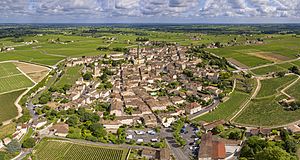
The Bordeaux wine region has about 116,160 hectares (287,000 acres) of vineyards. There are 57 different wine areas and 10,000 wine estates. About 13,000 grape growers work here. Bordeaux produces about 960 million bottles of wine each year. This includes everyday wines and some of the most expensive wines in the world.
Red Bordeaux wine is often called claret in the United Kingdom. It is usually a mix of grapes like Cabernet Sauvignon and Merlot. White Bordeaux wine is made from Sauvignon blanc and Sémillon grapes. Sauternes is a special area known for its sweet white dessert wines.
The Cité du Vin opened in June 2016. It is a museum and a place for exhibitions about wine.
Other Industries
The Laser Mégajoule is one of the world's most powerful lasers. It is used for research in laser and plasma technology.
About 15,000 people in Bordeaux work in the aviation industry. Big companies like Dassault and Thales Group are here. They build private jets, military aircraft, and parts for rockets.
Tourism, especially wine tourism, is a big industry. Bordeaux was named the best tourist destination in Europe in 2015.
The port is important for trade. Almost nine million tons of goods pass through it each year.
Major Companies in Bordeaux
Many important companies are based in Bordeaux or have a large presence there. Some of them include:
- Arena
- Cdiscount
- Dassault
- Marie Brizard
- McKesson Corporation
- Oxbow
- Ricard
- Sanofi Aventis
- Snecma
- Thales Group
Population of Bordeaux
| Largest groups of immigrants living in the Bordeaux metropolitan area | |
| Country of birth | Population (2019) |
|---|---|
| 15,551 | |
| 15,207 | |
| 10,006 | |
| 7,756 | |
| 4,231 | |
| 2,875 | |
| 2,683 | |
| 2,373 | |
| 2,197 | |
| 1,784 | |
| 1,759 | |
| 1,724 | |
| 1,603 | |
| 1,589 | |
In January 2020, the city of Bordeaux had 259,809 residents. The city's population was largest in 1954, with 284,494 people. Most people in Bordeaux are French. But there are also many people from Italy, Spain, Portugal, and Turkey.
The city has grown beyond its original borders. By January 2020, the larger metropolitan area had 1,376,375 people. Only about one-fifth of these people lived in Bordeaux itself.
| Population of Bordeaux (commune) (incl. Caudéran annexed in 1965) |
|||||||||||||||||||||||||||||||||||||||||||||||||||||||||||||||||||||||||||||||||||||||||||||||||||||||||||||||||||
|---|---|---|---|---|---|---|---|---|---|---|---|---|---|---|---|---|---|---|---|---|---|---|---|---|---|---|---|---|---|---|---|---|---|---|---|---|---|---|---|---|---|---|---|---|---|---|---|---|---|---|---|---|---|---|---|---|---|---|---|---|---|---|---|---|---|---|---|---|---|---|---|---|---|---|---|---|---|---|---|---|---|---|---|---|---|---|---|---|---|---|---|---|---|---|---|---|---|---|---|---|---|---|---|---|---|---|---|---|---|---|---|---|---|---|---|
|
|
||||||||||||||||||||||||||||||||||||||||||||||||||||||||||||||||||||||||||||||||||||||||||||||||||||||||||||||||||
| Source: EHESS and INSEE | |||||||||||||||||||||||||||||||||||||||||||||||||||||||||||||||||||||||||||||||||||||||||||||||||||||||||||||||||||
Education in Bordeaux
Universities and Colleges
A university was first created by the Romans in 286 AD. It taught rhetoric and grammar to train administrators.
In 1441, a new university was started when Bordeaux was an English town. This university was closed during the French Revolution in 1793. It was reopened by Napoleon in 1808. Today, Bordeaux has about 70,000 students. It has one of the largest university campuses in Europe.
Schools and Institutes
Bordeaux has many public and private schools. They offer programs for both undergraduate and postgraduate studies.
Some of the engineering schools include:
- Arts et Métiers ParisTech
- École nationale supérieure d'électronique, informatique, télécommunications, mathématique et mécanique de Bordeaux (ENSEIRB-MATMECA)
Business and management schools include:
- INSEEC Business School
- KEDGE Business School
Other important schools are:
- French National School for the Judiciary (for judges and lawyers)
- École d'architecture et de paysage de Bordeaux (architecture and landscape)
- École des beaux-arts de Bordeaux (fine arts)
Main Sights and Attractions
Historic Buildings and Architecture
Bordeaux is known as a "City of Art and History." It has 362 historic buildings, second only to Paris in France. The "Port of the Moon" area is a World Heritage Site. It is famous for its beautiful 18th-century architecture.
Many buildings were designed by the architects Gabriel father and son for King Louis XV of France.
Some important sights include:
- Place de la Bourse (1735–1755): A grand square with the Fountain of the Three Graces.
- Grand Théâtre (1780): A large, beautiful neoclassical theater.
- Place des Quinconces: The largest square in France.
- Bordeaux Cathedral (Saint André): A large cathedral consecrated in 1096.
- Tour Pey-Berland (1440–1450): A tall Gothic tower next to the cathedral.
- Sainte-Croix church: An old church with Romanesque style.
- Saint Michel Basilica: A Gothic church built between the late 14th and 16th centuries.
- Palais Rohan: Once the archbishop's home, now the city hall.
- Palais Gallien: The remains of a Roman amphitheater from the 2nd century.
- Porte Cailhau: A medieval gatehouse in the old city walls.
- La Grosse Cloche (15th century): Another medieval gate with a large bell.
- Rue Sainte-Catherine: The longest pedestrian street in France, full of shops.
-
Bordeaux Cathedral (Saint André)
Modern Architecture
Bordeaux also has interesting modern buildings:
- Cité Frugès: A district built by Le Corbusier (1924–1926), also a UNESCO heritage site.
- Court of first instance: Designed by Richard Rogers in 1998.
- Cité du Vin: A unique building about wine, opened in 2016.
- MECA: A creative and cultural center, opened in 2019.
Museums to Explore
Bordeaux has many museums:
- Musée des Beaux-Arts: A fine arts museum with paintings by famous artists like Rubens and Picasso.
- Musée d'Aquitaine: An archeology and history museum.
- Musée du Vin et du Négoce: A museum about the wine trade.
- Cité du Vin: A museum dedicated to wine culture.
- CAPC musée d'art contemporain de Bordeaux: A modern art museum.
- Musée Mer Marine: A museum about the sea and navy.
Remembering History: Slavery in Bordeaux
Bordeaux was an important port for the slave trade in the 18th and 19th centuries. About 500 slave expeditions from Bordeaux led to the forced movement of 150,000 Africans. The city also traded directly with Caribbean colonies, which relied on enslaved labor for goods like sugar and coffee. Many people from Aquitaine moved to these colonies, especially Saint-Domingue (now Haiti). They became wealthy from plantations until slave revolts led to the final end of slavery in France in 1848.
In 2019, a statue of Modeste Testas was unveiled. She was an Ethiopian woman enslaved by Bordeaux plantation owners. The Musée d'Aquitaine has exhibits dedicated to Bordeaux's role in the transatlantic slave trade.
Parks and Gardens
Bordeaux has many green spaces to enjoy:
- Jardin public de Bordeaux: A large public garden with a botanical garden inside.
- Jardin botanique de la Bastide: Another botanical garden.
- Parc bordelais: A big park for relaxation.
- Parc aux Angéliques
- Jardin des Lumières
Pont Jacques Chaban-Delmas
The Pont Jacques Chaban-Delmas is Europe's longest vertical-lift bridge. It opened in 2013 over the Garonne River. Its middle section is 117 meters (384 ft) long and can lift up to 53 meters (174 ft) high. This allows tall ships to pass underneath. The bridge is named after Jacques Chaban-Delmas, a former Prime Minister and Mayor of Bordeaux.
Shopping in Bordeaux
Bordeaux offers many shopping choices. Rue Sainte-Catherine is a pedestrian-only shopping street. It is 1.2 km (0.75 mi) long and has many shops, restaurants, and cafés. It is one of the longest shopping streets in Europe. The shops become more high-end as you move towards Place de la Comédie.
Culture and Arts
Bordeaux is home to the Opéra national de Bordeaux. It also has many cinemas and theaters. The city hosts several festivals throughout the year. In 2021, Bordeaux was considered for the European Capital of Smart Tourism award.
Transportation in Bordeaux
Roads and Bridges
Bordeaux is a major road and motorway hub. Motorways connect it to Paris, Lyon, Toulouse, and Spain. A 45 km (28 mi) long ring road, called the "Rocade", circles the city.
Bordeaux has five road bridges over the Garonne River. The Pont de pierre was built in the 1820s. Other modern bridges include the Pont Saint Jean and the Pont d'Aquitaine. The Pont Jacques-Chaban-Delmas opened in 2013. All five bridges are open to cyclists and pedestrians.
Bordeaux is good for cycling because it has no steep hills. There are special cycle paths along the river and on university campuses. A bike-sharing system was started in 2010.
Train Travel
The main train station is Gare de Bordeaux Saint-Jean. It serves 12 million passengers each year. High-speed trains (TGV) connect Bordeaux to Paris in just over two hours. There are also connections to other major European cities. Regional trains (TER) connect Bordeaux to nearby towns.
A new four-track railway bridge opened in 2009. This replaced an older bridge built by Gustave Eiffel. The new bridge allows trains to travel faster.
Air Travel
Bordeaux is served by Bordeaux–Mérignac Airport. It is located 8 km (5 mi) from the city center in Mérignac.
Trams, Buses, and Boats
Bordeaux has a good public transport system called Transports Bordeaux Métropole (TBM). It includes:
- Four tram lines (A, B, C, and D).
- 75 bus routes that connect to the tram network.
- Night bus routes.
- An electric bus shuttle in the city center.
- A boat shuttle on the Garonne river.
The tram system uses a special ground-level power supply. This avoids overhead cables in the historic city. The tram system was completed in 2003. In April 2023, the tram line A was extended to Mérignac airport.
On average, people in Bordeaux spend 51 minutes commuting by public transport on a weekday. The average wait time at a stop is 13 minutes.
Sports in Bordeaux
The Nouveau Stade de Bordeaux is the city's largest stadium. It holds 41,458 people and opened in 2015. It replaced the Stade Chaban-Delmas, which hosted games for the FIFA World Cup in 1938 and 1998.
Bordeaux has two main sports teams:
- Girondins de Bordeaux: A football (soccer) team. They are one of France's most successful clubs.
- Union Bordeaux Bègles: A rugby team that plays in the top French league.
Skateboarding, rollerblading, and BMX biking are popular activities. There is a large skate-park along the Garonne river.
Other sports clubs include the ice hockey team Boxers de Bordeaux and the basketball team JSA Bordeaux Basket. Bordeaux also has a strong cricket team.
The Vélodrome du Lac is a 250-meter (820 ft) wooden velodrome. It hosts international cycling competitions.
Famous People from Bordeaux
- Ausonius (310–395), Roman poet
- Rosa Bonheur (1822–1899), famous animal painter
- René Clément (1913–1996), film director
- Eleanor of Aquitaine (1122–1204), Queen of France and England
- François Mauriac (1885–1970), writer and Nobel Prize winner
- Michel de Montaigne (1533–1592), famous essayist
- Montesquieu (1689–1755), important political thinker
- Odilon Redon (1840–1916), painter
- Richard II of England (1367–1400), King of England
- Soko (born 1985), singer
International Connections
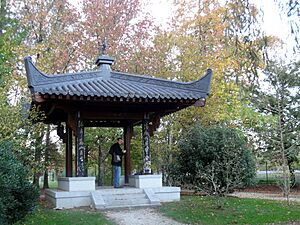
Twin Towns and Sister Cities
Bordeaux has many twin towns and sister cities around the world:
 Ashdod, Israel (since 1984)
Ashdod, Israel (since 1984) Bilbao, Spain
Bilbao, Spain Baku, Azerbaijan (since 1985)
Baku, Azerbaijan (since 1985) Bristol, United Kingdom (since 1947)
Bristol, United Kingdom (since 1947) Casablanca, Morocco (since 1988)
Casablanca, Morocco (since 1988) Fukuoka, Japan (since 1982)
Fukuoka, Japan (since 1982) Kraków, Poland (since 1993)
Kraków, Poland (since 1993) Lima, Peru (since 1957)
Lima, Peru (since 1957) Los Angeles, California, United States (since 1968)
Los Angeles, California, United States (since 1968) Madrid, Spain (since 1984)
Madrid, Spain (since 1984) Munich, Germany (since 1964)
Munich, Germany (since 1964) Oran, Algeria (since 2003)
Oran, Algeria (since 2003) Porto, Portugal (since 1978)
Porto, Portugal (since 1978) Quebec City, Quebec, Canada (since 1962)
Quebec City, Quebec, Canada (since 1962) Ramallah, Palestine
Ramallah, Palestine Riga, Latvia
Riga, Latvia Saint Petersburg, Russia (since 1993)
Saint Petersburg, Russia (since 1993) Wuhan, China (since 1998)
Wuhan, China (since 1998)
Partnerships
 Samsun, Turkey (since 2010)
Samsun, Turkey (since 2010)
See also
 In Spanish: Burdeos para niños
In Spanish: Burdeos para niños


